[Part one of this series can be found here.]
Early on, Prime Minister Erdoğan refused to refer to the Gezi Park protesters as a civil movement comprised of various demographics. Instead, he dismissed them as “marginal groups” and as misbehaving “çapulcus,” a term meaning marauder, low-life, riffraff, or bum. As with so many of Erdoğan’s bombastic edicts, both the terms “marginal” and “bum” went through the movement’s satirical machinery. In the process, the “marginals” came to denote the now vocal center, while “çapulcu” served as a descriptor for anyone resisting state oppression and corruption while concurrently demanding the rule of law, freedom of speech, and a truly participatory democracy. The honorific title of çapulcu thus became the highest badge of merit for anyone taking part in the Gezi Park demonstrations. What’s more, the term became so widespread that it spawned its very own Wikipedia entry, television channel, and related commercial products.
Besides its semantic turnabout, the term çapulcu benefited from the movement’s musical output, which played a key role in mobilizing demonstrators both online and in the park. At its genesis, no doubt, was the musical video “Everyday I’m Çapullin’,” which coopted the title of LMFAO’s “Everyday I’m Shufflin’.” This new protest tune was set to a mosaic of excerpted videos of the demonstrations, including a protester wearing a gas mask performing Michael Jackson’s moonwalk along with the dance moves to the Bee Gees’ “Stayin’ Alive” in the midst of a confrontation with the police.
The çapulcu dancer wearing a gas mask turned viral and quickly joined other slogans and stenciled icons of the resistance, including those demanding the resignation of “Chemical Tayyip.” Along with other calls for resistance and revolution, the song’s title also was inscribed as graffiti on walls around Taksim Square. Other graffiti adopted LMFAO’s sarcastically egomaniacal song “I’m sexy and I know it” under the new rubric “I’m sexy and çapulcu.” Similarly, handmade signs pasted on walls as personal mementos urged participants to “Çapul out, man!”
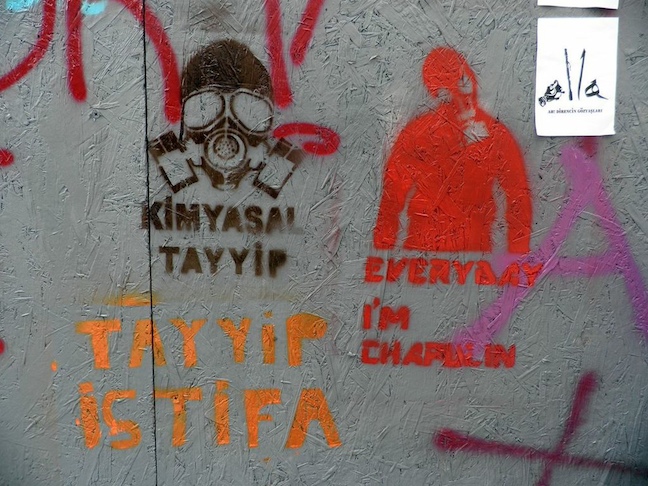
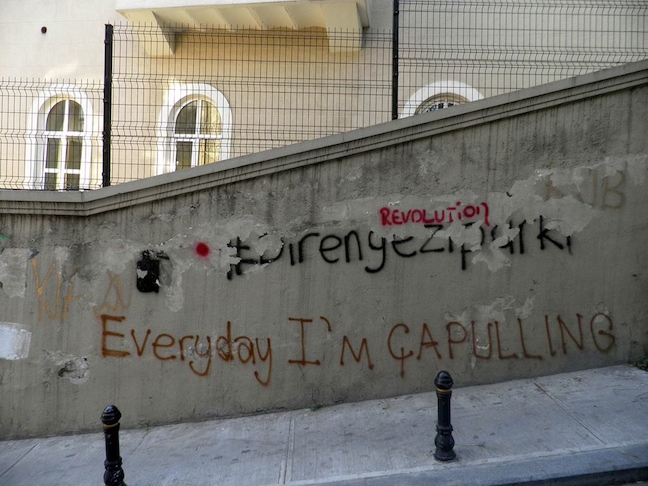
[Left: Çapulcu dancer wearing a gas mask, with a caption reading “Everyday I’m Chapulin” alongside “Chemical Tayyip” and
“Tayyip Resign,” Galatasaray, 6 June 6. Right:“Everyday I’m Çapullin’” Cihangir, 8 June. Photos: Christiane Gruber.]

[Right: “I’m sexy and çapulcu” Gümüşsuyu, 9 June. Right: “Çapul out, man!” Gümüşsuyu, 6 June. Photos: Christiane Gruber)
Live musical performances also took place in Gezi Park, Taksim Square, and numerous other public spaces in Turkey (and abroad). Within Gezi Park, the talented undergraduate students of Boğaziçi University’s Jazz Chorus not only pitched their tent, occupying the park like other demonstrators, but also offered musical entertainment to those spending their days and nights nesting on park grounds.

[Tent of the Boğaziçi University’s Jazz Chorus, Gezi Park, 10 June. Photo: Christiane Gruber.]
Their most famous a capella performance was entitled “Çapulcu musun vay vay, eylemci misin, vay vay?” (“Are you a bum, vay vay, are you a demonstrator, vay vay?”). The song jokingly praises the honey-scented smell of pepper gas along with other rhyming lyrics that draw antithetical analogies between natural beauty and police brutality. Moreover, the song cleverly appropriates and parodies both the melody and themes of the song “Entarisi Ala Benziyor” [Her Dress Resembles Red], which only makes the modern twist on an old classic all the more appealing in its absurdity and irreverence.
Members of the older generation were inspired by (and protective of) the younger members of the Occupy Gezi movement, and so followed their lead in greater masses. For instance, along with a number of other union members declaring a general “bums’ strike,” teachers, professors, and university staff also staged several marches. So out came the “marginal” and “bum” teachers and other honorary çapulcu professors, who walked in waves from Tünel to Taksim during the month of June.

[“The bums are on strike,” union march on Istiklal Avenue, 4 June. Photo: Christiane Gruber.]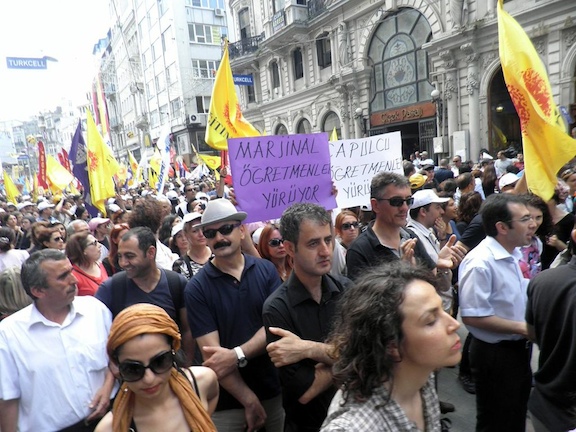
[“Marginal” and “bum” teachers on strike, union march on Istiklal Avenue, 4 June. Photo: Christiane Gruber.]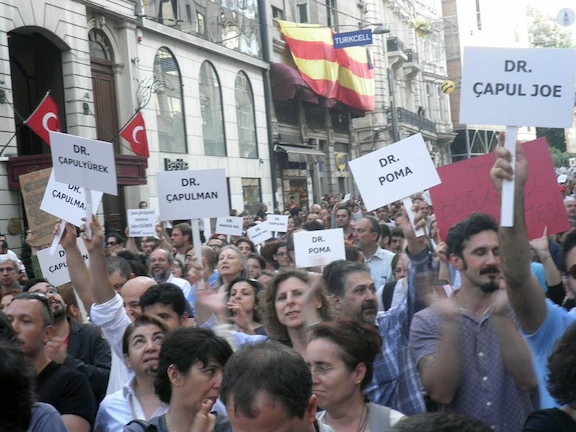
[Çapulcu professors, march on Istiklal Avenue, 6 June. Photo: Christiane Gruber.]
In the pedagogical milieu, the English verb “to çapul” was coined and conjugated in an online classroom session. Moreover, the sayings of great authors and thinkers served as ingenious political commentary by the scholarly bums who posed questions such “To çapul or not to çapul” or else declared “I çapul, therefore I am.” To top it off, modern philosopher and political activist Noam Chomsky came out in support of the movement, calling himself a çapulcu as well.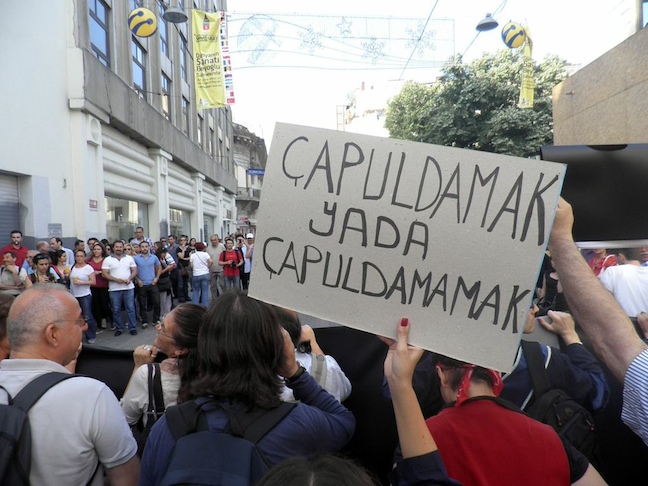

[“To çapul or not to çapul,” march on Istiklal Avenue, 6 June. “I çapul, therefore I am,” Gümüşsuyu, 6 June. Photos: Christiane Gruber.]
From street children to young professionals and the higher echelons of academe, the proud bums of the Gezi Park movement marched against Erdoğan’s crass paternalism and excessive police violence. Within the park proper, they squatted for the sake of democratic pluralism and against “AKP Fascism.” During the first two weeks of June, a quasi-independent commune thrived. This “Istanbul Bum Collective”—alternatively known as the “Tayyip Resign Collective”—included a substantial number of apolitical individuals who refused to commit to the ideological agendas of particular parties, whether right or left. From anti-capitalist Muslims to members of the LGBT Block, a plurality of voices were clamoring to be heard and taken into processes of decision-making, whose contours increasingly have been defined by the imperious fiat of the ruling cliques rather than through participatory democracy. Unable to speak up in other platforms while Erdoğan babbled on in his signature loops of logic, the çapulcus of Gezi Park had simply had enough, in the end exclaiming: “Shut your mouth, Tayyip, the bums are talking.”
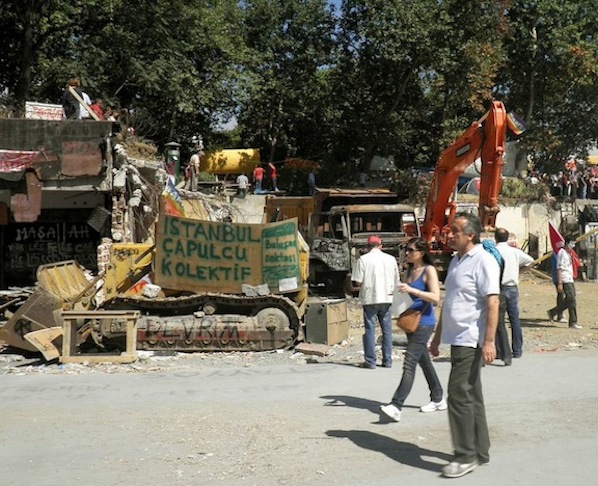

[Left: “Istanbul Bum Collective,” Taksim Square, 9 June. Right: “Tayyip Resign Collective,” Gezi Park, 6 June. Photos: Christiane Gruber.]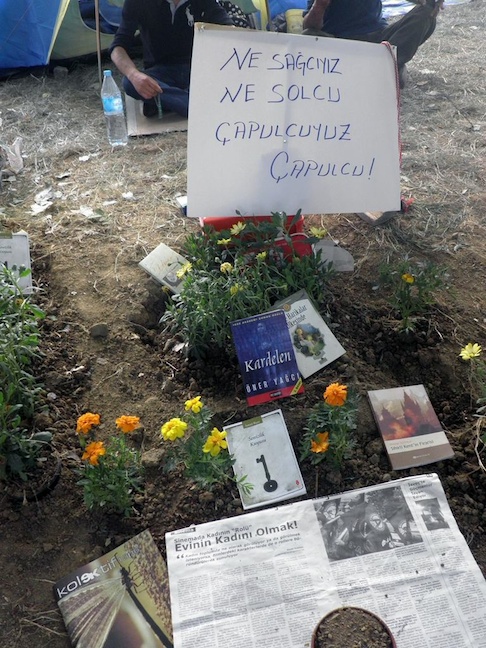
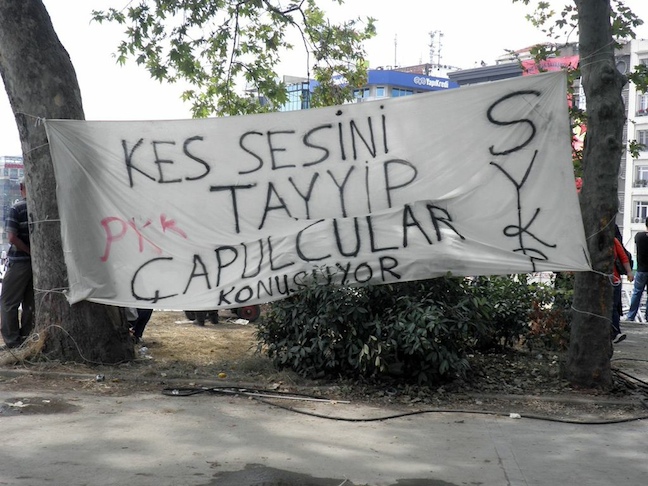
[Left: “Not right-wing or left-wing, we are çapulcus,” Gezi Park, 6 June. Right: “Shut your mouth,
Tayyip, the bums are talking,” Gezi Park, 5 June. Photos: Christiane Gruber.]
Though Gezi Park is now cleared of its temporary inhabitants, the protesters refuse to be cowed into silence. They have taken their discussions to the next level elsewhere, organizing people’s forums in other public parks and gaining strength through digital forums. Gathering in the streets and Taksim Square, they have stood in silent resistance in a practice known as the “Standing Man” (duran adam). They also have continued to organize marches to condemn the police attack of Kurdish protesters in Lice (28 June), to celebrate LGBT Day (30 June), and to mark the twentieth anniversary of the massacre of Alevis in Sivas (2 July). For these many causes, and for the sake of keeping the momentum alive, the Occupy Gezi protesters thus continue to çapul on today.
[Part three of this series can be found here.]
![[“I çapul, therefore I am,” graffiti on the ground, Gümüssuyu, 6 June 2013. Photo by Christiane Gruber.]](https://kms.jadaliyya.com/Images/357x383xo/Gruber_figure30.jpg)










